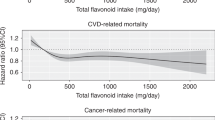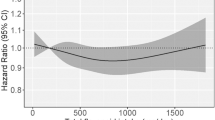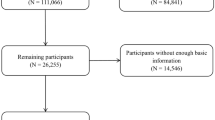Abstract
Background:
Limited epidemiological studies show inverse associations between dietary flavonoid intake and pancreatic cancer risk, but results are inconsistent and are based on few cases. We examined the association between intake of flavonoids and pancreatic cancer risk in the large, prospective National Institutes of Health-AARP Diet and Health Study Cohort.
Methods:
During follow-up through 2006 (median follow-up 10.6 years), 2379 pancreatic cancer cases were identified. We used Cox proportional hazards modelling to estimate hazard ratios (HRs) and 95% confidence intervals (CIs).
Results:
We found no association between total flavonoid intake (Q5 vs Q1 HR=1.09, 95% CI: 0.96–1.24) or any flavonoid subtypes and pancreatic cancer risk. Significant interactions were not observed by age, sex, smoking status, BMI or diabetes.
Conclusion:
Our results do not support the hypothesis that flavonoids have a protective role in pancreatic cancer carcinogenesis.
Similar content being viewed by others
Main
Flavonoids are the most common of the plant polyphenolics (Chun et al, 2007) and are thought to have chemoprotective properties (Ramos, 2008). Flavones, a flavonoid subtype, have shown inhibition of pancreatic cancer cell growth in vitro (Ujiki et al, 2006), and quercetin (a flavonol) has demonstrated inhibition of pancreatic cancer growth and prevention of metastasis in mice and in vitro (Mouria et al, 2002).
Some epidemiological studies on flavonoids and pancreatic cancer suggest an inverse association with intake of specific flavonoids, but results are inconsistent and based on few cases (range n=130–529) (Arts et al, 2002; Nöthlings et al, 2007; Bobe et al, 2008). We aimed to investigate the association between total flavonoid intake and six subtypes (flavan-3-ols, flavanones, flavonols, anthocyanidins, flavones, and isoflavones) and pancreatic cancer risk in the prospective National Institutes of Health (NIH)-AARP Diet and Health cohort.
Materials and Methods
Study population
The NIH-AARP Diet and Health Study has been described previously (Schatzkin et al, 2001). In short, 566 399 individuals aged 50–71 years completed mailed questionnaires in 1995–1996. After exclusions (proxy respondents, n=15 760; prevalent registry-confirmed cancers (except non-melanoma skin cancer), n=8585; death/moved before baseline questionnaire, n=24; >2 interquartile ranges above the 75th or below the 25th percentile on a logarithmic scale for calories, n=4810; and total flavonoid intake, n=116), the analytic cohort consisted of 537 104 persons.
Dietary assessment
Each participant completed a 124-item food frequency questionnaire (FFQ) developed at the US National Cancer Institute. The FFQ queried on usual frequency and portion size of foods and beverages consumed over the past year (10 categories of intake). Flavonoid intakes associated with each FFQ line item were calculated by multiplying amounts reported in the FFQ with food values from the database associated with 24-h dietary recalls collected in the 1994–1996 United States Department of Agriculture (USDA) Continuing Survey of Food Intakes by Individuals (CSFII) (Subar et al, 2000). Because the CSFII nutrient database did not originally include flavonoids, the 2007 USDA flavonoid database (385 foods) and the 2002 USDA isoflavonoid database were linked to the CSFII survey to provide nutrient values. Flavonoid values for processed foods were estimated assuming standard recipes. For processed foods that had only flavonoid or isoflavonoid values for raw foods, a 50% loss of flavonoid content during processing and preparation was assumed based on comparison of foods in the flavonoid databases that had both raw and processed values. Responses to the FFQ were validated against two non-consecutive, telephone administered, 24-h dietary recalls obtained within a year of the baseline questionnaire among a stratified random sample of participants (n=2053) (Thompson et al, 2008); deattenuated flavonoid correlation coefficients were 0.57 for males and 0.65 for females.
Case ascertainment
Incident cancers were identified by linkage to 11 state registries. Pancreatic cancer deaths ascertained using the US National Death Index were also counted as cases. Cancer registry case ascertainment is estimated to be about 90% complete (Michaud et al, 2005). Vital status was determined annually by linkage to the Social Security Administration Death Master File and cancer registry. We included exocrine pancreatic cancer cases diagnosed through 2006 (codes C250-C259 in the International Classification of Diseases for Oncology, third edition).
Statistical analysis
Average daily flavonoid intakes were nutrient density adjusted (Willett et al, 1997) and divided into sex-specific quintiles. Hazard ratios (HRs) and two-sided 95% confidence intervals (CIs) were estimated using Cox proportional hazards models with age as the underlying time metric. Person-years of follow-up were calculated from baseline questionnaire to cancer diagnosis, death, emigration from study area or end of follow-up. We examined characteristics in Table 1 as potential confounders. We adjusted for putative risk factors and those that changed log parameter estimates by >10%. Final models were adjusted for sex, smoking, diabetes, BMI, and intakes of alcohol, calories, saturated fat and red meat.
We evaluated the proportional hazards assumption using interaction terms of the continuous exposure with follow-up time. To calculate P-trend, we created ordinal variables using quintile median intake levels and assessed the variable as linear. Potential effect modification was explored using stratified analyses and multiplicative interaction testing. In sensitivity analyses, we excluded subjects with <1 and <4 follow-up years to test the influence of subclinical disease on observed associations. Statistical analyses were performed using SAS version 9.2 (SAS Institute, Inc, Cary, NC, USA).
Results
Over a median follow-up of 10.6 years, 2379 pancreatic cancer cases were identified (1541 men and 838 women). Participants with higher flavonoid intake were more educated, less likely to smoke, and consumed less red meat, fat, and alcohol (Table 1). Primary flavonoid dietary sources are presented in Supplementary Table 1.
Total flavonoid intake was not associated with risk of pancreatic cancer (Q5 vs Q1 HR=1.09, 95% CI: 0.96–1.24) (Table 2). Specific flavonoid subtypes showed no significant associations with pancreatic cancer risk comparing extreme quintiles, although anthocyanidin intake showed a slight positive trend (Ptrend=0.02).
In additional analyses, sex, age, smoking (Supplementary Table 2), BMI, and diabetes did not appear to modify the association between flavonoids and pancreatic cancer risk (data not shown). Excluding subjects with <1 or <4 years of follow-up did not change the association.
Discussion
In this large, prospective study, we observed no association between flavonoid intake and pancreatic cancer. In contrast, lower pancreatic cancer risk was observed with higher flavonol intake (Q5 vs Q1 HR=0.77, 95% CI: 0.58–1.03) in the Multiethnic Cohort (MEC) (Nöthlings et al, 2007). The MEC participants might have unique tea-consumption patterns, given the large Japanese population, which was the largest ethnic group represented in the highest flavonol quintile. When MEC was stratified by ethnicity, no association was observed among Caucasians. Mean flavonol intake was estimated at 14.8 mg per day in MEC, compared with 20.4 mg per day in NIH-AARP, although it is difficult to compare values from different FFQs, as they are only semi-quantitative. In the Alpha Tocopherol Beta Carotene (ATBC) Study of male Finnish smokers, no overall association between flavonoid intake and pancreatic cancer risk was observed, but in stratified analysis, higher total flavonoid intake was associated with decreased pancreatic cancer risk in trial participants randomised to placebo (Q4 vs Q1 HR=0.36, 95% CI: 0.17–0.78) but not to supplemental α-tocopherol and/or β-carotene (Pinteraction=0.002) (Bobe et al, 2008). The ATBC study included fewer cases, and flavonoid intake was lower than in our population (median energy-adjusted daily total flavonoid intake 121.5 mg in ATBC highest quintile compared with 388.0 mg for NIH-AARP), perhaps because of differences in dietary patterns in Finland, dietary questionnaires, or the number and type of foods included in reference databases. The Iowa Women’s Health Study showed no association (Q4 vs Q1 HR=0.74, 95% CI: 0.46–1.20) between dietary catechins and pancreatic cancer (Arts et al, 2002). We captured catechins under the flavan-3-ol subtype, rather than isolating the specific flavonoid.
In vitro, polyphenols have demonstrated antioxidant properties (Halliwell, 2008). Antioxidants may protect against cancer risk by stimulating apoptosis and inhibiting reactive oxygen species (ROS) from inducing oxidative carcinogenic damage in DNA (Salganik, 2001). However, polyphenols have also shown pro-oxidant properties (Ahmad et al, 1992). Laboratory studies have reported that the role of ROS in pancreatic cancer cells is complicated, as some enzymes mediating ROS production may protect pancreatic cancer cells from apoptosis (Vaquero et al, 2004). The relationship between antioxidant intake from flavonoids and pancreatic cancer may also differ in vivo from in vitro. One cross-over feeding study showed little variation in human F2-isoprostane plasma levels (biomarkers of oxidative damage) between flavonoid-rich and -poor diets (Halliwell, 2008). Generally, human plasma concentrations of flavonoids are low, and flavonoid metabolites show less antioxidant activity than parent compounds (Halliwell et al, 2005).
Strengths of our study include the largest sample of incident pancreatic cancer cases in a flavonoid analysis to date, allowing for exploration of effect modification by other risk factors. Our flavonoid intake data were linked to updated USDA food databases, including a greater scope of foods than in previous studies. Limitations of our study include measurement errors associated with FFQs and potential errors in the nutrient database used to calculate flavonoid values. The updated food databases in our study provided more foods with calculated flavonoid values, but make comparison of calculated flavonoid levels between studies difficult. Although our reported flavonoid values are higher than reported levels in other studies, our FFQ did not include specific questions on flavonoid-rich foods, such as specific types of tea, berries (other than strawberries), and tofu. Still, usual intake of these foods is low in the United States (US Population, 2001–04), and thus unlikely to greatly affect intake estimates. We could not account for absorption levels of various flavonoids because the understanding of flavonoid absorption and metabolism is still limited and differs by individual flavonoid (Scalbert et al, 2002). Finally, our participants were largely non-Hispanic white, and thus our results may not generalise to other populations.
In conclusion, we observed no association between flavonoid intake and pancreatic cancer risk. Future studies may want to evaluate flavonoid intake among non-white populations or populations with broader exposure ranges. However, our results suggest evaluating other modifiable risk factors for pancreatic cancer.
Change history
19 March 2013
This paper was modified 12 months after initial publication to switch to Creative Commons licence terms, as noted at publication
References
Ahmad MS, Fazal F, Rahman A, Hadi S, Parish J (1992) Activities of flavonoids for the cleavage of DNA in the presence of Cu (II): correlation with generation of active oxygen species. Carcinogenesis 13 (4): 605–608
Arts ICW, Jacobs DR, Gross M, Harnack LJ, Folsom AR (2002) Dietary catechins and cancer incidence among postmenopausal women: the Iowa Women's Health Study (United States). Cancer Causes Control 13 (4): 373–382
Bobe G, Weinstein SJ, Albanes D, Hirvonen T, Ashby J, Taylor PR, Virtamo J, Stolzenberg-Solomon RZ (2008) Flavonoid intake and risk of pancreatic cancer in male smokers (Finland). Cancer Epidemiol Biomarkers Prev 17 (3): 553
Chun OK, Chung SJ, Song WO (2007) Estimated dietary flavonoid intake and major food sources of US adults. J Nutr 137 (5): 1244
Halliwell B (2008) Are polyphenols antioxidants or pro-oxidants? What do we learn from cell culture and in vivo studies? Arch Biochem Biophys 476 (2): 107–112
Halliwell B, Rafter J, Jenner A (2005) Health promotion by flavonoids, tocopherols, tocotrienols, and other phenols: direct or indirect effects? Antioxidant or not? Am J Clin Nutr 81 (1): 268S–276S
Michaud D, Midthune D, Hermansen S, Leitzmann M, Harlan L, Kipnis V, Schatzkin A (2005) Comparison of cancer registry case ascertainment with SEER estimates and self-reporting in a subset of the NIH-AARP Diet and Health Study. J Registry Manage 32 (2): 70–75
Mouria M, Gukovskaya AS, Jung Y, Buechler P, Hines OJ, Reber HA, Pandol SJ (2002) Food derived polyphenols inhibit pancreatic cancer growth through mitochondrial cytochrome C release and apoptosis. Int J Cancer 98 (5): 761–769
Nöthlings U, Murphy SP, Wilkens LR, Henderson BE, Kolonel LN (2007) Flavonols and pancreatic cancer risk. Am J Epidemiol 166 (8): 924
Ramos S (2008) Cancer chemoprevention and chemotherapy: dietary polyphenols and signalling pathways. Mol Nutr Food Res 52 (5): 507–526
Salganik RI (2001) The benefits and hazards of antioxidants: controlling apoptosis and other protective mechanisms in cancer patients and the human population. J Am Coll Nutr 20 (5 Suppl): 464S–472S,, discussion 473S-475S
Scalbert A, Morand C, Manach C, Rémésy C (2002) Absorption and metabolism of polyphenols in the gut and impact on health. Biomed Pharmacother 56 (6): 276–282
Schatzkin A, Subar AF, Thompson FE, Harlan LC, Tangrea J, Hollenbeck AR, Hurwitz PE, Coyle L, Schussler N, Michaud DS (2001) Design and serendipity in establishing a large cohort with wide dietary intake distributions. Am J Epidemiol 154 (12): 1119
Subar AF, Midthune D, Kulldorff M, Brown CC, Thompson FE, Kipnis V, Schatzkin A (2000) Evaluation of alternative approaches to assign nutrient values to food groups in food frequency questionnaires. Am J Epidemiol 152 (3): 279–286
Thompson FE, Kipnis V, Midthune D, Freedman LS, Carroll RJ, Subar AF, Brown CC, Butcher MS, Mouw T, Leitzmann M (2008) Performance of a food-frequency questionnaire in the US NIH-AARP (National Institutes of Health-American Association of Retired Persons) Diet and Health Study. Public Health Nutr 11 (2): 183–195
Ujiki MB, Ding XZ, Salabat MR, Bentrem DJ, Golkar L, Milam B, Talamonti MS, Bell RH, Iwamura T, Adrian TE (2006) Apigenin inhibits pancreatic cancer cell proliferation through G2/M cell cycle arrest. Mol Cancer 5 (1): 76
Usual Dietary Intakes: Food Intakes, US Population, 2001–04. Risk Factor Monitoring and Methods Branch Web site. Applied Research Program. National Cancer Institute. http://riskfactor.cancer.gov/diet/usualintakes/pop/. Updated December 21, 2010. Accessed December 17, 2012
Vaquero EC, Edderkaoui M, Pandol SJ, Gukovsky I, Gukovskaya AS (2004) Reactive oxygen species produced by NAD(P)H oxidase inhibit apoptosis in pancreatic cancer cells. J Biol Chem 279 (33): 34643–34654
Willett WC, Howe GR, Kushi LH (1997) Adjustment for total energy intake in epidemiologic studies. Am J Clin Nutr 65 (4 Suppl): 1220S–1228S,, discussion 1229S-1231S
Acknowledgements
This work was supported in part by the pre-doctoral training grant T32 CA105666. This research was also supported in part by the Intramural Research Program of the National Institutes of Health, National Cancer Institute. Cancer incidence data from the Atlanta metropolitan area were collected by the Georgia Center for Cancer Statistics, Department of Epidemiology, Rollins School of Public Health, Emory University. Cancer incidence data from California were collected by the California Department of Health Services, Cancer Surveillance Section. Cancer incidence data from the Detroit metropolitan area were collected by the Michigan Cancer Surveillance Program, Community Health Administration, State of Michigan. The Florida cancer incidence data used in this report were collected by the Florida Cancer Data System under contract with the Florida Department of Health. The views expressed herein are solely those of the authors and do not necessarily reflect those of the contractor or the Department of Health. Cancer incidence data from Louisiana were collected by the Louisiana Tumor Registry, Louisiana State University Medical Center in New Orleans. Cancer incidence data from New Jersey were collected by the New Jersey State Cancer Registry, Cancer Epidemiology Services, New Jersey State Department of Health and Senior Services. Cancer incidence data from North Carolina were collected by the North Carolina Central Cancer Registry. Cancer incidence data from Pennsylvania were supplied by the Division of Health Statistics and Research, Pennsylvania Department of Health, Harrisburg, Pennsylvania. The Pennsylvania Department of Health specifically disclaims responsibility for any analyses, interpretations, or conclusions. Cancer incidence data from Arizona were collected by the Arizona Cancer Registry, Division of Public Health Services, Arizona Department of Health Services. Cancer incidence data from Texas were collected by the Texas Cancer Registry, Cancer Epidemiology and Surveillance Branch, Texas Department of State Health Services. Cancer incidence data from Nevada were collected by the Nevada Central Cancer Registry, Center for Health Data and Research, Bureau of Health Planning and Statistics, State Health Division, State of Nevada Department of Health and Human Services. We also thank Sigurd Hermansen and Kerry Grace Morrissey from Westat for ascertainment and management of study outcomes, and Leslie Carroll at Information Management Services for data support and analysis.
Author information
Authors and Affiliations
Corresponding author
Additional information
Supplementary Information accompanies this paper on British Journal of Cancer website
Supplementary information
Rights and permissions
From twelve months after its original publication, this work is licensed under the Creative Commons Attribution-NonCommercial-Share Alike 3.0 Unported License. To view a copy of this license, visit http://creativecommons.org/licenses/by-nc-sa/3.0/
About this article
Cite this article
Arem, H., Bobe, G., Sampson, J. et al. Flavonoid intake and risk of pancreatic cancer in the National Institutes of Health-AARP Diet and Health Study Cohort. Br J Cancer 108, 1168–1172 (2013). https://doi.org/10.1038/bjc.2012.584
Received:
Revised:
Accepted:
Published:
Issue Date:
DOI: https://doi.org/10.1038/bjc.2012.584
Keywords
This article is cited by
-
Dietary total antioxidant capacity and pancreatic cancer risk: an Italian case–control study
British Journal of Cancer (2016)
-
Epigenetic activities of flavonoids in the prevention and treatment of cancer
Clinical Epigenetics (2015)



